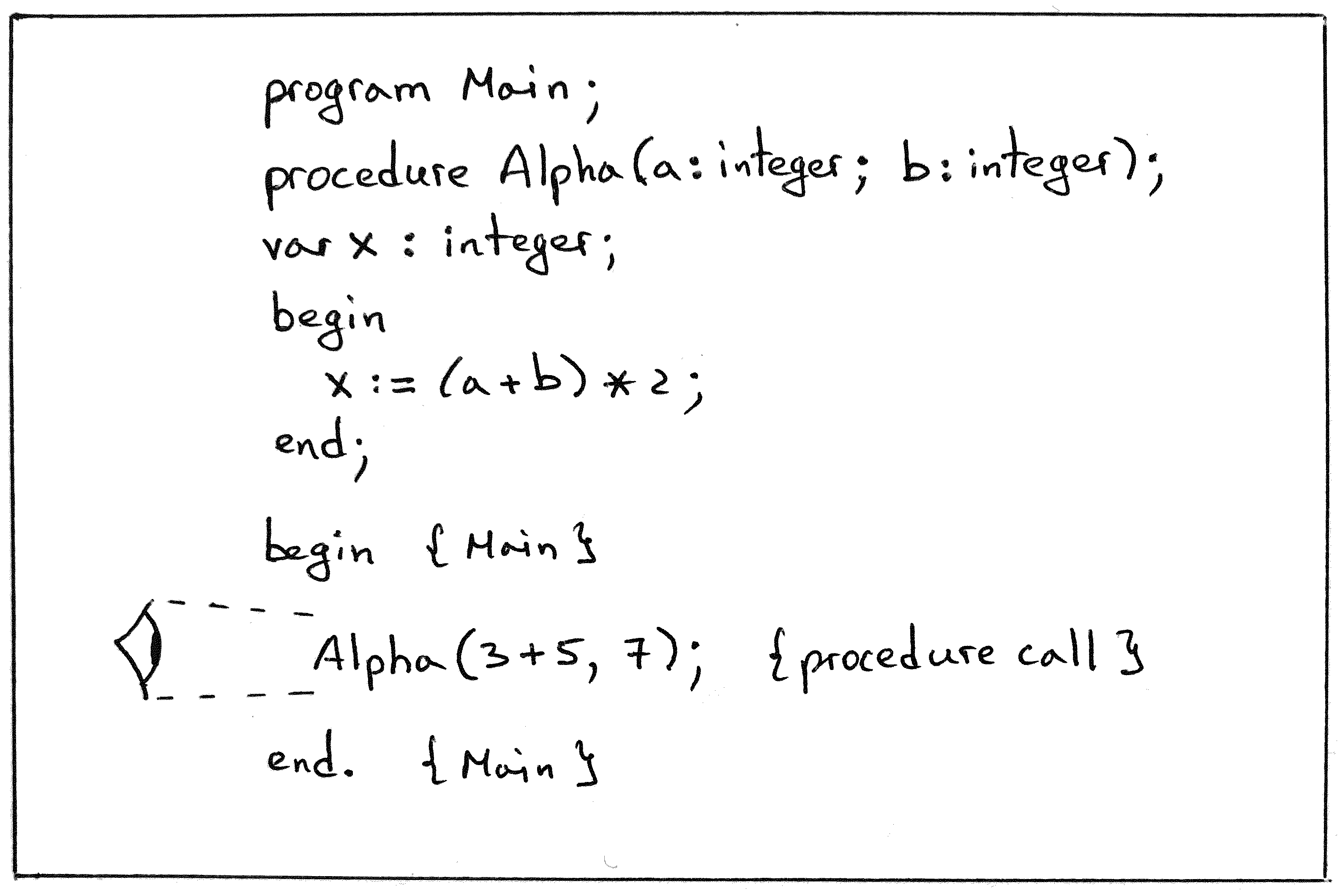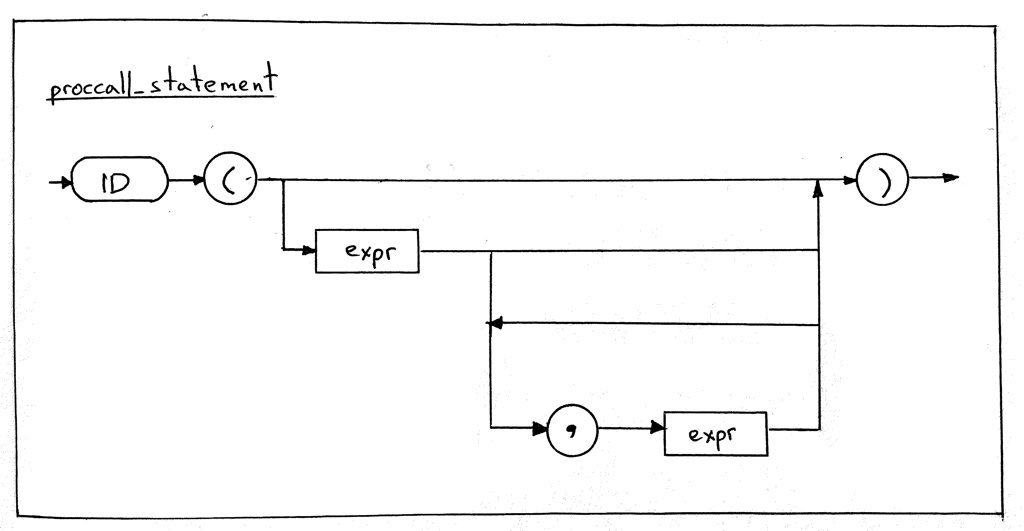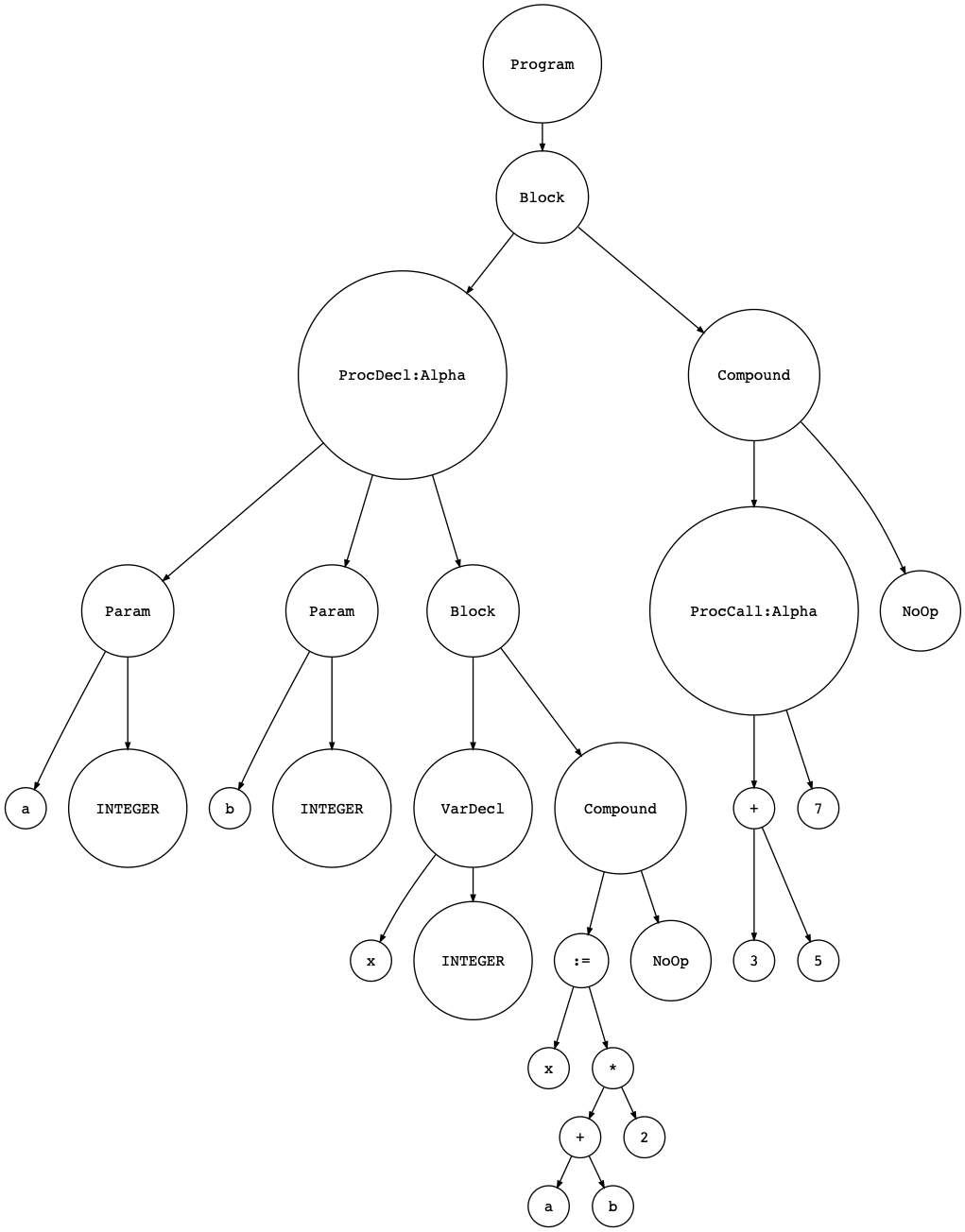“Learning is like rowing upstream: not to advance is to drop back.” — Chinese proverb
Today we’re going to extend our interpreter to recognize procedure calls. I hope by now you’ve flexed your coding muscles and are ready to tackle this step. This is a necessary step for us before we can learn how to execute procedure calls, which will be a topic that we will cover in great detail in future articles.
The goal for today is to make sure that when our interpreter reads a program with a procedure call, the parser constructs an Abstract Syntax Tree (AST) with a new tree node for the procedure call, and the semantic analyzer and the interpreter don’t throw any errors when walking the AST.
Let’s take a look at a sample program that contains a procedure call Alpha(3 + 5, 7):

Making our interpreter recognize programs like the one above will be our focus for today.
As with any new feature, we need to update various components of the interpreter to support this feature. Let’s dive into each of those components one by one.
First, we need to update the parser. Here is a list of all the parser changes that we need to make to be able to parse procedure calls and build the right AST:
- We need to add a new AST node to represent a procedure call
- We need to add a new grammar rule for procedure call statements; then we need to implement the rule in code
- We need to extend the statement grammar rule to include the rule for procedure call statements and update the statement method to reflect the changes in the grammar
1. Let’s start by creating a separate class to represent a procedure call AST node. Let’s call the class ProcedureCall:
class ProcedureCall(AST):
def __init__(self, proc_name, actual_params, token):
self.proc_name = proc_name
self.actual_params = actual_params # a list of AST nodes
self.token = token
The ProcedureCall class constructor takes three parameters: a procedure name, a list of actual parameters (a.k.a arguments), and a token. Nothing really special here, just enough information for us to capture a particular procedure call.
2. The next step that we need to take is to extend our grammar and add a grammar rule for procedure calls. Let’s call the rule proccall_statement:
proccall_statement : ID LPAREN (expr (COMMA expr)*)? RPAREN
Here is a corresponding syntax diagram for the rule:

From the diagram above you can see that a procedure call is an ID token followed by a left parenthesis, followed by zero or more expressions separated by commas, followed by a right parenthesis. Here are some of the procedure call examples that fit the rule:
Alpha();
Alpha(1);
Alpha(3 + 5, 7);
Next, let’s implement the rule in our parser by adding a proccall_statement method
def proccall_statement(self):
"""proccall_statement : ID LPAREN (expr (COMMA expr)*)? RPAREN"""
token = self.current_token
proc_name = self.current_token.value
self.eat(TokenType.ID)
self.eat(TokenType.LPAREN)
actual_params = []
if self.current_token.type != TokenType.RPAREN:
node = self.expr()
actual_params.append(node)
while self.current_token.type == TokenType.COMMA:
self.eat(TokenType.COMMA)
node = self.expr()
actual_params.append(node)
self.eat(TokenType.RPAREN)
node = ProcedureCall(
proc_name=proc_name,
actual_params=actual_params,
token=token,
)
return node
The implementation is pretty straightforward and follows the grammar rule: the method parses a procedure call and returns a new ProcedureCall AST node.
3. And the last changes to the parser that we need to make are: extend the statement grammar rule by adding the proccall_statement rule and update the statement method to call the proccall_statement method.
Here is the updated statement grammar rule, which includes the proccall_statement rule:
statement : compound_statement
| proccall_statement
| assignment_statement
| empty
Now, we have a tricky situation on hand where we have two grammar rules - proccall_statement and assignment_statement - that start with the same token, the ID token. Here are their complete grammar rules put together for comparison:
proccall_statement : ID LPAREN (expr (COMMA expr)*)? RPAREN
assignment_statement : variable ASSIGN expr
variable: ID
How do you distinguish between a procedure call and an assignment in a case like that? They are both statements and they both start with an ID token. In the fragment of code below, the ID token’s value(lexeme) for both statements is foo:
foo(); { procedure call }
foo := 5; { assignment }
The parser should recognize foo(); above as a procedure call and foo := 5; as an assignment. But what can we do to help the parser to distinguish between procedure calls and assignments? According to our new proccall_statement grammar rule, procedure calls start with an ID token followed by a left parenthesis. And that’s what we are going to rely on in the parser to distinguish between procedure calls and assignments to variables - the presence of a left parenthesis after the ID token:
if (self.current_token.type == TokenType.ID and
self.lexer.current_char == '('
):
node = self.proccall_statement()
elif self.current_token.type == TokenType.ID:
node = self.assignment_statement()
As you can see in the code above, first we check if the current token is an ID token and then we check if it’s followed by a left parenthesis. If it is, we parse a procedure call, otherwise we parse an assignment statement.
Here is the full updated version of the statement method:
def statement(self):
"""
statement : compound_statement
| proccall_statement
| assignment_statement
| empty
"""
if self.current_token.type == TokenType.BEGIN:
node = self.compound_statement()
elif (self.current_token.type == TokenType.ID and
self.lexer.current_char == '('
):
node = self.proccall_statement()
elif self.current_token.type == TokenType.ID:
node = self.assignment_statement()
else:
node = self.empty()
return node
So far so good. The parser can now parse procedure calls. One thing to keep in mind though is that Pascal procedures don’t have return statements, so we can’t use procedure calls in expressions. For example, the following example will not work if Alpha is a procedure:
x := 10 * Alpha(3 + 5, 7);
That’s why we added proccall_statement to the statements method only and nowhere else. Not to worry, later in the series we’ll learn about Pascal functions that can return values and also can be used in expressions and assignments.
These are all the changes for our parser. Next up is the semantic analyzer changes.
The only change we need to make in our semantic analyzer to support procedure calls is to add a visit_ProcedureCall method:
def visit_ProcedureCall(self, node):
for param_node in node.actual_params:
self.visit(param_node)
All the method does is iterate over a list of actual parameters passed to a procedure call and visit each parameter node in turn. It’s important not to forget to visit each parameter node because each parameter node is an AST sub-tree in itself.
That was easy, wasn’t it? Okay, now moving on to interpreter changes.
The interpreter changes, compared to the changes to the semantic analyzer, are even simpler - we only need to add an empty visit_ProcedureCall method to the Interpreter class:
def visit_ProcedureCall(self, node):
pass
With all the above changes in place, we now have an interpreter that can recognize procedure calls. And by that I mean the interpreter can parse procedure calls and create an AST with ProcedureCall nodes corresponding to those procedure calls. Here is the sample Pascal program we saw at the beginning of the article that we want our interpreter to be tested on:
program Main;
procedure Alpha(a : integer; b : integer);
var x : integer;
begin
x := (a + b ) * 2;
end;
begin { Main }
Alpha(3 + 5, 7); { procedure call }
end. { Main }
Download the above program from GitHub or save the code to the file part16.pas
See for yourself that running our updated interpreter with the part16.pas as its input file does not generate any errors:
$ python spi.py part16.pas
$
So far so good, but no output is not that exciting. :) Let’s get a bit visual and generate an AST for the above program and then visualize the AST using an updated version of the genastdot.py utility:
$ python genastdot.py part16.pas > ast.dot && dot -Tpng -o ast.png ast.dot

That’s better. In the picture above you can see our new ProcCall AST node labeled ProcCall:Alpha for the Alpha(3 + 5, 7) procedure call. The two children of the ProcCall:Alpha node are the subtrees for the arguments 3 + 5 and 7 passed to the Alpha(3 + 5, 7) procedure call.
Okay, we have accomplished our goal for today: when encountering a procedure call, the parser constructs an AST with a ProcCall node for the procedure call, and the semantic analyzer and the interpreter don’t throw any errors when walking the AST.
Now, it’s time for an exercise.

Exercise: Add a check to the semantic analyzer that verifies that the number of arguments (actual parameters) passed to a procedure call equals the number of formal parameters defined in the corresponding procedure declaration. Let’s take the Alpha procedure declaration we used earlier in the article as an example:
procedure Alpha(a : integer; b : integer);
var x : integer;
begin
x := (a + b ) * 2;
end;
The number of formal parameters in the procedure declaration above is two (integers a and b). Your check should throw an error if you try to call the procedure with a number of arguments other than two:
Alpha(); { 0 arguments —> ERROR }
Alpha(1); { 1 argument —> ERROR }
Alpha(1, 2, 3); { 3 arguments —> ERROR }
You can find a solution to the exercise in the file solutions.txt on GitHub, but try to work out your own solution first before peeking into the file.
That’s all for today. In the next article we’ll begin to learn how to interpret procedure calls. We will cover topics like call stack and activation records. It is going to be a wild ride :) So stay tuned and see you next time!
Resources used in preparation for this article:
Get the edge and stay sharp. Subscribe to Beyond Basics for free and get new posts without missing a beat!
All articles in this series:
- Let's Build A Simple Interpreter. Part 1.
- Let's Build A Simple Interpreter. Part 2.
- Let's Build A Simple Interpreter. Part 3.
- Let's Build A Simple Interpreter. Part 4.
- Let's Build A Simple Interpreter. Part 5.
- Let's Build A Simple Interpreter. Part 6.
- Let's Build A Simple Interpreter. Part 7.
- Let's Build A Simple Interpreter. Part 8.
- Let's Build A Simple Interpreter. Part 9.
- Let's Build A Simple Interpreter. Part 10.
- Let's Build A Simple Interpreter. Part 11.
- Let's Build A Simple Interpreter. Part 12.
- Let's Build A Simple Interpreter. Part 13.
- Let's Build A Simple Interpreter. Part 14.
- Let's Build A Simple Interpreter. Part 15.
- Let's Build A Simple Interpreter. Part 16.
- Let's Build A Simple Interpreter. Part 17.
- Let's Build A Simple Interpreter. Part 18.
Comments
comments powered by Disqus